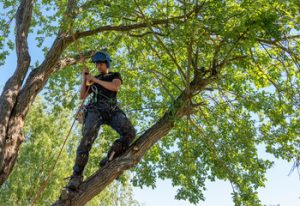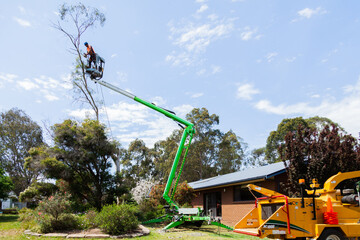Tree removal is crucial for safety and property care. Dead or damaged trees can fall unexpectedly. Removing them prevents accidents. It also protects homes and infrastructure nearby.

Not all tree removals are emergencies. Some are planned for landscaping improvements. Others are necessary to prevent disease spread. Timing can reduce risks and costs.
Tree health assessment is the first step. Professionals evaluate trunk stability and root integrity. Signs of decay or pest infestation guide decisions. Accurate assessment ensures safe removal.
Specialized equipment makes removal efficient. Cranes, ropes, and saws handle large trees. Proper tools reduce hazards. Technology improves precision and speed.
Urban tree removal poses unique challenges. Limited space and overhead wires complicate work. Professionals plan routes carefully. Safety for workers and property is the priority.
Environmental considerations are growing in importance. Removed trees may be repurposed into mulch or timber. Recycling reduces waste. Sustainability is integrated into modern practices.
Tree pruning often precedes removal. Cutting excess branches prevents injury during felling. It also reduces weight and wind resistance. Planning minimizes surprises during removal.
Root removal requires attention to soil health. Roots left in place can cause regrowth or pest attraction. Excavation may require heavy machinery. Professionals balance thoroughness with minimal soil disruption.
Emergency removals happen after storms. High winds can break or uproot trees. Immediate action prevents further property damage. Safety assessments determine the next steps.
Large trees often need sectional removal. Cutting in parts reduces the risk of uncontrolled falls. Cranes or pulleys may guide each segment down. Controlled removal is safer and more predictable.
Tree removal affects surrounding ecosystems. Birds and small animals may rely on the tree. Professionals relocate wildlife when possible. Environmental impact is considered alongside safety.
Diseased trees require careful handling. Fungal infections or infestations can spread. Removal prevents contamination of nearby trees. Sanitation measures ensure safety.
Stump grinding is a common follow-up. Grinding prevents tripping hazards. It also eliminates aesthetic concerns. Proper equipment completes the removal process efficiently.
Access issues influence removal techniques. Narrow alleys or fences may limit equipment use. Creative solutions are required. Planning avoids property damage and delays.
Insurance and liability are part of professional removal. Accidents can be costly without coverage. Licensed providers manage risks. Proper documentation protects both homeowners and workers.
Seasonal timing affects tree removal. Winter may make soil hard, complicating root removal. Summer storms increase the risk of emergency calls. Professionals schedule removals for optimal safety.
Tree removal also relates to landscaping design. Clearing certain trees opens light for new plantings. It can reshape views and spaces. Professionals collaborate with designers for best results.
Large root systems may require excavation. Roots can interfere with foundations or underground utilities. Careful planning prevents structural damage. Professionals map underground obstacles before starting.
Chemical treatments sometimes prevent regrowth. Applied correctly, they stop sprouting from stumps. This reduces repeat removal. Safety precautions ensure chemicals do not harm soil or water.
Tree felling training is essential for crews. Mistakes in cutting angles or notching can be dangerous. Professionals practice regularly to maintain skills. Safety remains the top priority.
Urban planning often involves tree removal. Sidewalks, roads, and buildings require clear space. Removing trees may improve accessibility. Planners weigh benefits against environmental loss.
Debris management is part of the process. Branches and logs are transported or recycled. Mulching reduces waste and creates usable products. Efficiency in cleanup improves overall workflow.
Tree removal can prevent structural damage. Roots growing into pipes or foundations cause costly repairs. Removing problematic trees protects property. Early action reduces long-term costs.
Hazardous trees are identified through inspection. Leaning, cracked, or hollow trees pose high risk. Professionals assess probability of failure. Decisions balance safety and preservation.
Tree removal enhances sunlight exposure. Removing overgrown branches or trees brightens spaces. Increased light benefits lawns and gardens. It also improves home energy efficiency.
Noise reduction is a consideration. Chainsaws and machinery create significant sound. Professionals minimize disturbance through careful scheduling. Community impact is considered during operations.
Tree removal affects water flow in the soil. Large roots absorb significant water. Removing them may require adjustments in irrigation. Professionals plan to avoid soil erosion.
Insurance requirements often dictate professional involvement. DIY removals can void homeowner coverage. Licensed removal ensures compliance. Proper procedures protect all parties.
Seasonal wildlife patterns affect timing. Birds may nest in branches. Relocation ensures safety for animals. Consideration reduces ecological impact.
Advanced cutting techniques increase safety. Directional cuts guide trees safely to the ground. Professionals avoid collateral damage. Proper technique minimizes risk to property.
Trees near utilities require specialized attention. Overhead power lines pose electrocution risks. Underground cables complicate root removal. Coordination with service providers ensures safety.
Mulching and wood recycling add value. Removed material can enhance gardens or landscaping projects. Chips prevent soil erosion. Sustainability integrates with removal practices.
Tree removal contracts specify responsibilities. Clear agreements prevent misunderstandings. Homeowners know what services are included. Professionals clarify scope, safety, and disposal.
Emergency response teams specialize in high-risk removals. Crews handle fallen trees blocking roads or threatening structures. Training ensures speed and safety. Rapid intervention reduces further damage.
Tree removal contributes to disease management. Infected or invasive species threaten local flora. Removal prevents wider outbreaks. Professionals follow strict protocols.
Insurance companies sometimes require removal after damage. Storm-hit trees increase liability risks. Removing them mitigates claims. Proper documentation supports insurance processes.
Community projects may involve coordinated removals. Public spaces require careful planning. Safety for pedestrians is paramount. Trees are often replaced with new plantings.
Tree removal also intersects with historical preservation. Some trees have cultural or aesthetic significance. Professionals assess value before action. Preservation may alter removal methods.
Large-scale removals require logistics planning. Transporting wood and debris is a significant challenge. Scheduling crews, equipment, and disposal sites is critical. Efficiency reduces cost and time.
Tree removal impacts soil stability. Large root systems anchor terrain. Removing trees may require soil reinforcement. Proper preparation prevents erosion and structural issues.
Environmental regulations affect removal practices. Certain trees require permits. Professionals ensure legal compliance. Avoiding fines protects homeowners and crews.
Tree removal often pairs with replanting. New trees may offset loss. Selection considers species, soil, and sunlight. Replanting supports ecosystem health.
Modern technology aids tree removal decisions. Drones and sensors assess tree stability. Digital mapping identifies obstacles. Professionals use data for precision planning.
Community education often accompanies removal projects. Homeowners learn about tree health and maintenance. Awareness prevents unnecessary removal. Education promotes responsible stewardship.
Tree removal affects aesthetics. Clearing overgrown areas improves visibility. It can enhance property value. Professionals balance visual appeal with environmental considerations.
Soil and nutrient management follow removal. Excavated areas need restoration. Professionals enrich soil for new plantings. Proper care maintains landscape health.
Tree removal in residential areas requires careful communication. Neighbors are informed about timing and risks. Clear signage and scheduling minimize conflicts. Safety and courtesy are emphasized.
Equipment maintenance is crucial for removal crews. Chainsaws, ropes, and cranes must function reliably. Regular checks prevent accidents. Efficiency depends on well-maintained tools.
Stump removal can prevent pest attraction. Termites and rodents use old stumps for shelter. Grinding or chemical treatment eliminates hazards. Ongoing monitoring ensures long-term effectiveness.
Tree removal often intersects with urban planning goals. Clearing for roads, sidewalks, or utilities is necessary. Professionals coordinate with planners and engineers. Projects balance functionality and greenery.
Emergency protocols are standardized. Crews respond with defined steps. Safety of workers, residents, and property is prioritized. Efficient procedures reduce risk.
Tree removal continues to evolve with innovation. Modern equipment, environmental considerations, and planning improve results. Safety, efficiency, and sustainability guide the process. Professionals ensure that every removal is precise, responsible, and effective.
